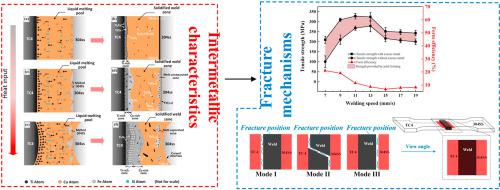当前位置:
X-MOL 学术
›
Intermetallics
›
论文详情
Our official English website, www.x-mol.net, welcomes your
feedback! (Note: you will need to create a separate account there.)
Influence of heat input on the intermetallic compound characteristics and fracture mechanisms of titanium-stainless steel MIG-TIG double-sided arc welding joints
Intermetallics ( IF 4.3 ) Pub Date : 2020-12-01 , DOI: 10.1016/j.intermet.2020.106973 Zhi Cheng , Zheng Ye , Jihua Huang , Jian Yang , Shuhai Chen , Xingke Zhao
Intermetallics ( IF 4.3 ) Pub Date : 2020-12-01 , DOI: 10.1016/j.intermet.2020.106973 Zhi Cheng , Zheng Ye , Jihua Huang , Jian Yang , Shuhai Chen , Xingke Zhao

|
Abstract The influence of the heat input on the intermetallic compound (IMC) characteristics and the fracture mechanisms of titanium-stainless steel MIG-TIG double-sided arc welding (DSAW) joints using Cu–Si welding wire were studied. The results show that the MIG-TIG DSAW method can effectively control the microstructural characteristics by the heat input regulation. The Ti side interfaces were composed of IMC layers, mainly of Ti–Cu phases, and the thickness of the layers increased with increasing heat input. At the low heat input, the joints fractured at the 304SS side interface, which was embrittled by the straight IMC layer with the brittle TiFeSi and λ, Ti(Fe1-xSix)2 (0-x-0.375) phases. With increasing heat input, the melting of the 304SS reduced the interface brittleness by dispersing the brittle λ phase by softer Fe (s,s) and Cu (s,s) phases. At the high heat input, with the melted zone separated from the base metal, the remain-curved 304SS side interface improved the tensile resistance by increasing the load-bearing area. The fracture occurred at the Ti side interface, which embrittled by the thick IMC layers with a thickness greater than 130 μm. With the increase of the heat input, the joints showed an increase in tensile strength at the 304SS side interface but a decrease at the Ti side interface. The optimal tensile strength of 320 MPa was thus obtained in the joint under intermediate heat input, with a fracture position mixed with the Ti side interface and 304SS side interface.
中文翻译:

热输入对钛-不锈钢MIG-TIG双面电弧焊接头金属间化合物特性及断裂机制的影响
摘要 研究了热输入对使用Cu-Si焊丝的钛-不锈钢MIG-TIG双面电弧焊(DSAW)接头的金属间化合物(IMC)特性和断裂机制的影响。结果表明,MIG-TIG DSAW方法可以通过热输入调节有效地控制微观结构特性。Ti侧界面由IMC层组成,主要是Ti-Cu相,层的厚度随着热输入的增加而增加。在低热输入下,接头在 304SS 侧界面处断裂,该界面被具有脆性 TiFeSi 和 λ, Ti(Fe1-xSix)2 (0-x-0.375) 相的直 IMC 层脆化。随着热输入的增加,304SS 的熔化通过较软的 Fe (s,s) 和 Cu (s, s) 阶段。在高热输入下,熔化区与母材分离,保留弯曲的 304SS 侧界面通过增加承载面积提高了抗拉强度。断裂发生在 Ti 侧界面,其被厚度大于 130 μm 的厚 IMC 层脆化。随着热输入的增加,接头在 304SS 侧界面的拉伸强度增加,但在 Ti 侧界面的拉伸强度下降。因此在中等热输入下的接头中获得了 320 MPa 的最佳拉伸强度,断裂位置与 Ti 侧界面和 304SS 侧界面混合。断裂发生在 Ti 侧界面,其被厚度大于 130 μm 的厚 IMC 层脆化。随着热输入的增加,接头在 304SS 侧界面的拉伸强度增加,但在 Ti 侧界面的拉伸强度下降。因此在中等热输入下在接头中获得了 320 MPa 的最佳拉伸强度,断裂位置与 Ti 侧界面和 304SS 侧界面混合。断裂发生在 Ti 侧界面,其被厚度大于 130 μm 的厚 IMC 层脆化。随着热输入的增加,接头在 304SS 侧界面的拉伸强度增加,但在 Ti 侧界面的拉伸强度下降。因此在中等热输入下的接头中获得了 320 MPa 的最佳拉伸强度,断裂位置与 Ti 侧界面和 304SS 侧界面混合。
更新日期:2020-12-01
中文翻译:

热输入对钛-不锈钢MIG-TIG双面电弧焊接头金属间化合物特性及断裂机制的影响
摘要 研究了热输入对使用Cu-Si焊丝的钛-不锈钢MIG-TIG双面电弧焊(DSAW)接头的金属间化合物(IMC)特性和断裂机制的影响。结果表明,MIG-TIG DSAW方法可以通过热输入调节有效地控制微观结构特性。Ti侧界面由IMC层组成,主要是Ti-Cu相,层的厚度随着热输入的增加而增加。在低热输入下,接头在 304SS 侧界面处断裂,该界面被具有脆性 TiFeSi 和 λ, Ti(Fe1-xSix)2 (0-x-0.375) 相的直 IMC 层脆化。随着热输入的增加,304SS 的熔化通过较软的 Fe (s,s) 和 Cu (s, s) 阶段。在高热输入下,熔化区与母材分离,保留弯曲的 304SS 侧界面通过增加承载面积提高了抗拉强度。断裂发生在 Ti 侧界面,其被厚度大于 130 μm 的厚 IMC 层脆化。随着热输入的增加,接头在 304SS 侧界面的拉伸强度增加,但在 Ti 侧界面的拉伸强度下降。因此在中等热输入下的接头中获得了 320 MPa 的最佳拉伸强度,断裂位置与 Ti 侧界面和 304SS 侧界面混合。断裂发生在 Ti 侧界面,其被厚度大于 130 μm 的厚 IMC 层脆化。随着热输入的增加,接头在 304SS 侧界面的拉伸强度增加,但在 Ti 侧界面的拉伸强度下降。因此在中等热输入下在接头中获得了 320 MPa 的最佳拉伸强度,断裂位置与 Ti 侧界面和 304SS 侧界面混合。断裂发生在 Ti 侧界面,其被厚度大于 130 μm 的厚 IMC 层脆化。随着热输入的增加,接头在 304SS 侧界面的拉伸强度增加,但在 Ti 侧界面的拉伸强度下降。因此在中等热输入下的接头中获得了 320 MPa 的最佳拉伸强度,断裂位置与 Ti 侧界面和 304SS 侧界面混合。











































 京公网安备 11010802027423号
京公网安备 11010802027423号